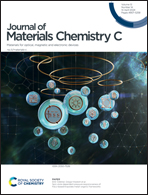Modulating Fermi energy in few-layer MoS2via metal passivation with enhanced detectivity for near IR photodetector†
Abstract
Atomic layered molybdenum sulfide (MoS2) opens new avenues for healthcare, protective surveillance and optical communications using rationally developed broadband photodetectors as it exhibits high carrier mobility and high optical transparency. The current research shows that the good photo response of few-layered MoS2 prepared via chemical vapor deposition (CVD) can be surprisingly improved by boosting its charge mobility via metal surface passivation. The passivation of Fe and Zn reduced the surface dangling bonds of MoS2. This led to the maximum photocurrent, spectral response (Rλ) and external quantum efficiency (EQE) of about 5.79 × 10−6 A, 1450 mA W−1 and 30.2%, respectively for Zn–MoS2. Upon illumination at 323 K, the current increased to 0.171 × 10−3 A with a large Seebeck coefficient of −45 mV K−1 at 318 K for Zn–MoS2. The increased Schottky barrier height (SBH) of about 0.39 eV for Zn-passivated MoS2 led to suppressed Fermi level pinning. Thus, rationally designed architecture provides a strategy for constructing 2D-based devices for photodetection.



 Please wait while we load your content...
Please wait while we load your content...